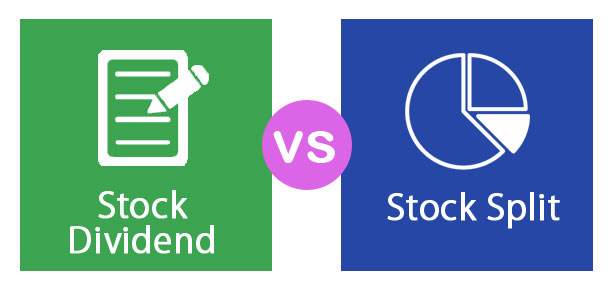Updated July 29, 2023

Difference Between Stock Dividend vs Stock Split
Cash Dividend means dividend which is paid to shareholders in Cash/ Bank. When a company doesn’t have cash for payment of dividends, it gives dividends in the form of equity or we can say that additional shares of the Company are allotted to the shareholder. This term is called Stock Dividend. Stock Split is one of the forms of Corporate Action. Stock Split and Stock Dividend are different, and cannot be used interchangeably. Let’s understand the Stock Split. As the name itself tells the meaning, Stock Split means splitting of Stock or Equity Shares. Stock splits are splitting of already issued shares to increase the no. of shares of the Company.
Stock Dividend
The distribution of Profit to Equity shareholders is known as Dividends. The dividend is of two types namely:
- Cash Dividend
- Stock Dividend
In simple words, the dividend which is paid in the form of equity or shares instead of Cash is known as Stock Dividend. Now the question comes why the Company pays a dividend in Equity Form. There are some reasons for distributing Stock dividends by the company. Below are the main reasons for stock dividends:
- The company doesn’t have sufficient cash to pay the dividend.
- To increase the Issued shares of the Company.
- To give the Tax benefit to the shareholder, which means that when a dividend is paid in Cash it is Taxable as Income, but when paid in the equity shares, it will be taxable only when the shareholder sells the shares. Hence, Investors will get tax benefits.
Advantages of Stock Dividend:
- Increase the Liquidity of Cash,
- Increases the Liquidity of Shares in the market
- Increases the investor interest in the company by giving Tax Benefits.
Stock Split
To understand it better let’s take an example, Mr. A is holding 10000 Shares of Company XYZ Limited having a face value of Rs. 100 and market value Rs. 150. Now, company XYZ Limited declares the Stock Split in the ratio of 2 for 1 which means that for every 1 share, a shareholder will get 1 more share. In this example, Mr. A is holding 10000 Shares, after the stock split his shareholding will increase to 20000 shares. Be noted that the price of the share due to stock split will go down and no. of shares will increase.
The stock split is performed by the company for increasing or decreasing the no. of shares in the market and the value of shares. The stock split which increases the no. of shares is called as forwarding Stock Split and stock split which decreases the no. of shares is called Reverse Stock Split. Why the Company performs the Stock Split? Reasons are as mentioned below:
- When the Board of Directors of the company thinks that the market price of the share is overpriced. Hence, to reduce the price of share.
- To increase the liquidity of shares.
- Due to the reduction of Price, it allows more investors to buy the shares.
Head to Head Comparison Between Stock Dividend vs Stock Split(Infographics)
Below is the top 6 difference between Stock Dividend vs Stock Split

Key Differences Between Stock Dividend vs Stock Split
Let us discuss some of the major differences between Stock Dividend vs Stock Split:
- A stock dividend means dividend which is paid in the form of additional shares whereas stock split is a division of issues shares in the ratio as decided by Company.
- In the Stock dividend, additional shares are given to shareholders whereas in stock split already issued shares are split in an agreed ratio. No additional shares are allotted
- The main reason for the stock dividend is due to the shortage of cash flow in the company whereas the main purpose for the stock split is for reducing the market price of the shares
- There is a Journal Entry passed for Stock Dividend i.e debiting the Reserves (Retained Earnings) and crediting the Issued Share Capital, whereas no Journal Entry is passed in case of Stock Split only the details are mentioned in issued share capital.
- In a stock dividend, existing shareholders are allotted additional shares whereas the shares which are already held are divided.
Stock Dividend vs Stock Split Comparison Table
Let’s look at the top 6 Comparison Between Stock Dividend vs Stock Split
| Basis of Comparison |
Stock Dividend |
Stock Split |
| Meaning | Dividend in the form of Equity Shares | Division of Equity Shares |
| Purpose | When there is no Cash Liquidity with the company | To reduce the market price of Share |
| Issued from | Issued from the Free Reserves | Only increase In the no. of shares, no change in Value of Issued Shares. |
| Shares | Additional Shares are allotted to existing shares Holder | Already Held Shares are divided |
| Accounting | Amount from Reserves is transferred to issued shares by passing Journal entry | Whereas no Journal Entry is passed in |
| Type | No type | Two types of Stock Split:
|
Conclusion
Stock Dividend vs Stock Split is both Corporate Action terms. Both have similarities but these are not similar. The Purpose of both Stock dividends vs Stock Splits is totally different from each other. Whenever these terms are used, one should not treat them as the same should be careful.
Recommended Articles
This has been a guide to the Top difference between Stock Dividend vs Stock Split. Here we also discuss the stock Dividend vs Stock Split key differences with Infographics and Comparison table. You may also have a look at the following articles to learn more –


